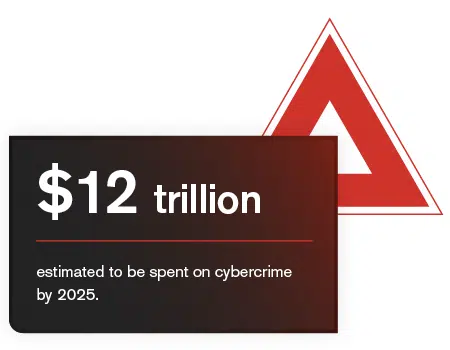With cybercrime projected to cost $12 trillion in 2025, regulators are expected to take a more active role in protecting consumer data, pushing organizations to adopt proactive and scalable security strategies that minimize financial and reputational damage (Forrester, 2024). This shift highlights the need for dynamic cybersecurity solutions that can scale effectively across cloud estates, endpoints, and even beyond nation-states, to keep pace with increasingly sophisticated threats.

Today’s enterprises operate across complex hybrid environments that include cloud platforms, mobile endpoints, IoT devices, and globally distributed teams. Every connection expands the attack surface, increasing exposure and complicating threat response. Traditional reactive security models which only respond after incidents occur fall short. Organizations must adopt forward-looking, scalable cybersecurity approaches that anticipate, detect, and neutralize threats before they cause disruption.
The Urgent Need for Scalable Cybersecurity
Scalable cybersecurity dynamically adapts defense strategies to match business growth, innovation, and threat sophistication. It incorporates real-time analytics, machine learning, and automation to stay ahead of attacks. Static tools are no match for today’s increasingly automated threat actors; therefore modern cybersecurity must continuously adjust and strengthen.
Scalability also enables the efficient processing of vast volumes of security data generated daily. Traditional tools often struggle to analyze this data quickly enough, delaying threat detection. Scalable platforms powered by AI and machine learning quickly identify anomalies and reduce response times, shrinking the window of opportunity for attackers.
Scaling Compliance Efforts
As enterprises expand, maintaining sovereignty and compliance becomes significantly more challenging, especially when operating in multiple regions with unique and fast-changing privacy laws. Navigating frameworks such as GDPR in Europe, CCPA in the United States, and a growing number of global data sovereignty mandates that require a more flexible and scalable approach to security compliance.
Scalable cybersecurity frameworks solve this by automating compliance processes and enforcing consistent security policies across all environments. Real-time compliance tracking helps organizations proactively identify and correct potential issues, reducing reliance on manual oversight and minimizing risk. These frameworks also adapt to regulatory updates automatically, ensuring ongoing alignment with changing legal obligations.
Unified Security Posture for Organizational Resilience
Scalable cybersecurity strengthens business resilience by creating a unified security posture across all operations. As organizations grow through mergers, acquisitions, or international expansion, they often inherit diverse systems and disjointed security practices. These inconsistencies create blind spots that adversaries can exploit.
A scalable approach standardizes controls, streamlines data governance, and integrates response protocols across departments and locations. It enables consistent enforcement of policies, centralized risk management, and enterprise-wide visibility into threats, these are all essential to improving detection and speeding up response.
Equally important, a unified security posture promotes collaboration between IT, compliance, and business units. By aligning cybersecurity with organizational priorities, security becomes a growth enabler not just a technical safeguard. This alignment ensures that as the business grows, its defenses grow with it, becoming stronger, smarter, and always ready.
Core Aspects of Scalable Deception Deployment
Implementing scalable deception technology requires a strategic foundation designed to meet the demands of complex digital infrastructures:
Automated Deception Deployment: Automation allows rapid deployment of decoys, breadcrumbs, and traps across growing networks. AI-driven orchestration keeps these deception assets responsive to real-time changes, reducing manual effort while boosting efficiency and protection.
Integration with Existing Security Stacks: Effective deception tools must integrate seamlessly with SIEM, SOAR, and endpoint security platforms. Through native connectors and APIs, these integrations streamline alert workflows and speed up threat response while reducing operational overhead.
High-Value Threat Detection: Deception technology focuses on capturing malicious behavior directly. By attracting real attackers rather than generating speculative alerts, it delivers high-confidence signals that sharpen response accuracy and reduce noise.
Cloud and Hybrid Scalability: Cloud-native deception platforms scale effortlessly across hybrid environments, from public and private clouds to on-prem infrastructure and containerized applications. This adaptability ensures continuous, consistent protection across all digital domains.
Together, these core components ensure deception technology not only scales with the enterprise but also delivers measurable security value with minimal disruption.
Scaling Security Across Distributed Digital Infrastructures
As organizations expand their digital footprint through multi-cloud deployments, hybrid systems, and widespread IoT and mobile adoption, security complexity increases. Addressing this requires cybersecurity strategies that scale natively with the business. Essential capabilities include:
- Comprehensive visibility: End-to-end insight across the entire digital ecosystem enables quick, effective detection and response, regardless of where a threat emerges.
- Seamless adaptability: Frameworks must accommodate new technologies and infrastructure changes without introducing security gaps or delays.
- Consistent policy enforcement: Applying uniform security controls across systems minimizes potential points of failure.
- Dynamic resource allocation: Security assets must adapt in real-time based on changing threat levels and operational priorities.
- Simplified compliance management: Unified compliance systems support adherence to a variety of regulations, reducing the risk of costly violations.
- Effective incident response: Automated response and orchestration ensure coordinated remediation, limiting downtime and impact.
By embracing scalable cybersecurity through dynamic deception, organizations can build security into their growth strategy, mitigating risk while remaining agile and prepared for what comes next.
How CounterCraft’s Platform Drives Global Scalability
CounterCraft’s Platform v4 delivers a new benchmark in scalable cybersecurity. Built on a distributed foundation with advanced multi-tenancy, it provides secure, compliant coverage across global operations and varied regulatory requirements, delivering specific, actionable threat intelligence powered by deception.
Key platform features include:
- Automated, Intelligent Deployment: Rapidly scales defenses across complex, dispersed environments without the need for constant manual input.
- Streamlined Workflow: Simplified interfaces reduce complexity, allowing security teams to focus on strategy rather than routine tasks.
- Resource Isolation and Compliance: Multi-tenant architecture securely separates departmental or client environments, ensuring privacy and regional compliance.
- Actionable, Real-Time Threat Intelligence: Continuously provides accurate intelligence on attacker behavior, enabling faster, more targeted defenses.
With cyber threats accelerating in both volume and complexity, CounterCraft equips organizations with the tools to stay prepared. To learn more about enhancing your scalable cybersecurity strategy, watch our webinar Scaling Against the Machines.
Take decisive action today by requesting a personalized demo of scalable deception technology. Follow us on LinkedIn for the latest insights in cybersecurity, deception, and threat intelligence.

